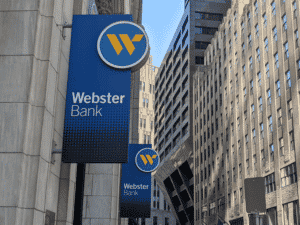With the pandemic driving many customers away from branches and accelerating the adoption of online and mobile technology, banks face the prospect of long-lasting changes to how they interact with customers.
“I think the billion-dollar question that everyone is trying to ask is, post-COVID, how much those behaviors – and to what degree – will persist,” said Brian Wallace, general manager of banking for Dedham-based Reflexis Systems. “Clearly, we’ve accelerated digital adoption, and I think it would be hard to believe that some of that is not going to persist in the future.”
Some banks have already decided to reduce their branch footprints. Berkshire Bank and Webster Bank announced this month plans to consolidate branches in Massachusetts and other states, with both banks citing the increased use of digital channels as a reason for the move.
But studies have shown that branches remain important to customers. If more branches do close in the coming months and years, the remaining offices could serve a different purpose than they had in the past.
“If you look at retail customers and small business customers, still a very high proportion of them say having a branch nearby is important to them,” said Jeff Marsico, an executive vice president with Pennsylvania-based consulting firm The Kafafian Group. “But what they want the branch for is problem solving, is advice, is loan opportunities, and what financial institutions have been slow to react to is changing the skill set of the staff within the branch to be responsive to the new demands on branch personnel by branch customers.”
Always a Role
Customer behavior during the pandemic is not the only factor leading banks to reconsider branch strategies. Pressure from ongoing low interest rates, plus increasing competition, have affected banks profitability, leading them to find ways to reduce expenses.
“One thing that banks tend to look at when facing a reduced profit scenario is to reduce expenses,” Marsico said. “And community financial institutions still have a very high proportion of expenses in the branch realm.”
When they complete their consolidations next year, Boston-based Berkshire Bank will reduce its branch footprint by 18 percent while Connecticut-based Webster Bank will shrink its branch network by 17 percent.
Berkshire Bank plans to sell eight Mid-Atlantic branches and close 16 branches in New England and New York. Only six of the branches being closed have been announced so far, including two in Western Massachusetts. Webster Bank said it will close 27 branches in New England, including one-third of its 29 Eastern Massachusetts branches.
Yet throughout the pandemic, banks have continued to open new branches. East Boston Savings Bank, HarborOne and Rockland Trust are just a few that have opened new locations in recent months.
One bank even entered the local retail market for the first time. Though it plans to close branches in other areas of the U.S., PNC moved forward with its Greater Boston expansion, which was announced before the start of the pandemic, opening five branches in the past two months.
Branch openings and closings have an ebb and flow to them, said Kathleen Murphy, who recently joined the Massachusetts Bankers Association as its new president and CEO.
“There’s always going to be a role for branches, but as consumer preferences change, what you see is that more analysis is being done by the industry to make sure that they have a proper structure in terms of their branch locations,” Murphy said.
An analysis by The Kafafian Group for the MBA found that in the 12-month period ending June 30, Massachusetts had 71 branches close, 44 branches open and 34 new branches proposed.
Even with mergers and acquisitions as a key driver in reducing the number of banks in Massachusetts over the past five years by 21 percent, the branch network has not dropped significantly. Massachusetts has about 2,100 branches, down only about 3 percent in the past five years, according to FDIC data.
Operational Agility
While multiple studies have shown that consumers want bank branches in their communities, the adoption of banking technology has accelerated.
A study by Morning Consult for the American Bankers Association showed that 36 percent of survey respondents used mobile apps most often to manage their bank accounts before the pandemic, increasing to 39 percent during the pandemic. More respondents said they most often used online tools during the pandemic, while bank customers most often using branches dropped from 17 percent to 10 percent once the pandemic hit.
This increased adoption of digital channels means that the branch model could shift from one of walk-in service to an advisory or outbound engagement center, said Wallace with Reflexis Systems, which was recently acquired by Zebra Technologies and provides workforce and organizational solutions in banking and other industries.
An approach banks could take to adapt to changes in how customers use branches, Wallace said, is to look at branch operations across the bank more holistically. From managing schedules to communications and training, having a consolidated and agile approach to branch operations could help increase efficiency and growth, Wallace said.
He added that having a complete understanding of the customers journey with the bank is also critical.

Diane McLauglin
“Continuing to understand the interplay between your digital and physical assets and how those come together for different customer segments to support your goals of growth and client retention are critically important,” Wallace said. “Those look very different for your different customer segments.”
Branches going forward could also have fewer employees. Instead of staffing for efficient transaction processing, Marsico said, branches would have a smaller staff with skill sets for providing advisory services. He added that branch personnel should also be versed in bank technology, giving them the same experience that customers have online, something which does not always happen today.
“Banks have to work toward creating an equally frictionless digital as well as in person experience for the customer,” Marsico said.






